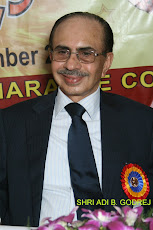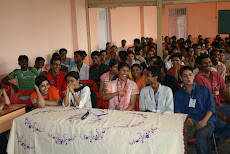Finland's teens score extraordinarily high on an international test.Am erican educators are trying to figure out why.
This article appeared in the WSJ . educators around the world were fascinated by the performance of the children from Finland. Let's have look at the report that made waves!
By ELLEN GAMERMAN February 29, 2008
Helsinki, Finland
High-school students here rarely get more than a half-hour of homework a night. They have no school uniforms, no honor societies, no valedictorians, no tardy bells and no classes for the gifted. There is little standardized testing, few parents agonize over college and kids don't start school until age 7.
Yet by one international measure, Finnish teenagers are among the smartest in the world. They earned some of the top scores by 15-year-old students who were tested in 57 countries. American teens finished among the world's C students even as U.S. educators piled on more homework, standards and rules. Finnish youth, like their U.S. counterparts, also waste hours online. They dye their hair, love sarcasm and listen to rap and heavy metal. But by ninth grade they're way ahead in math, science and reading -- on track to keeping Finns among the world's most productive workers.
The Finns won attention with their performances in triennial tests sponsored by the Organization for Economic Cooperation and Development, a group funded by 30 countries that monitors social and economic trends. In the most recent test, which focused on science, Finland's students placed first in science and near the top in math and reading, according to results released late last year. An unofficial tally of Finland's combined scores puts it in first place overall, says Andreas Schleicher, who directs the OECD's test, known as the Programme for International Student Assessment, or PISA. The U.S. placed in the middle of the pack in math and science; its reading scores were tossed because of a glitch. About 400,000 students around the world answered multiple-choice questions and essays on the test that measured critical thinking and the application of knowledge. A typical subject: Discuss the artistic value of graffiti.
The academic prowess of Finland's students has lured educators from more than 50 countries in recent years to learn the country's secret, including an official from the U.S. Department of Education. What they find is simple but not easy: well-trained teachers and responsible children. Early on, kids do a lot without adults hovering. And teachers create lessons to fit their students. "We don't have oil or other riches. Knowledge is the thing Finnish people have," says Hannele Frantsi, a school principal.
Visitors and teacher trainees can peek at how it's done from a viewing balcony perched over a classroom at the Norssi School in Jyväskylä, a city in central Finland. What they see is a relaxed, back-to-basics approach. The school, which is a model campus, has no sports teams, marching bands or prom.
Fanny Salo in class
Trailing 15-year-old Fanny Salo at Norssi gives a glimpse of the no-frills curriculum. Fanny is a bubbly ninth-grader who loves "Gossip Girl" books, the TV show "Desperate Housewives" and digging through the clothing racks at H&M stores with her friends.
Fanny earns straight A's, and with no gifted classes she sometimes doodles in her journal while waiting for others to catch up. She often helps lagging classmates. "It's fun to have time to relax a little in the middle of class," Fanny says. Finnish educators believe they get better overall results by concentrating on weaker students rather than by pushing gifted students ahead of everyone else. The idea is that bright students can help average ones without harming their own progress.
At lunch, Fanny and her friends leave campus to buy salmiakki, a salty licorice. They return for physics, where class starts when everyone quiets down. Teachers and students address each other by first names. About the only classroom rules are no cellphones, no iPods and no hats.
TESTING AROUND THE GLOBE
Every three years, 15-year-olds in 57 countries around the world take a test called the Pisa exam, which measures proficiency in math, science and reading.
• The test: Two sections from the Pisa science test
• Chart: Recent scores for participating countriesDISCUSS
Do you think any of these Finnish methods would work in U.S. schools? What would you change -- if anything -- about the U.S. school system, and the responsibilities that teachers, parents and students are given? Share your thoughts.
Fanny's more rebellious classmates dye their blond hair black or sport pink dreadlocks. Others wear tank tops and stilettos to look tough in the chilly climate. Tanning lotions are popular in one clique. Teens sift by style, including "fruittari," or preppies; "hoppari," or hip-hop, or the confounding "fruittari-hoppari," which fuses both. Ask an obvious question and you may hear "KVG," short for "Check it on Google, you idiot." Heavy-metal fans listen to Nightwish, a Finnish band, and teens socialize online at irc-galleria.net.
The Norssi School is run like a teaching hospital, with about 800 teacher trainees each year. Graduate students work with kids while instructors evaluate from the sidelines. Teachers must hold master's degrees, and the profession is highly competitive: More than 40 people may apply for a single job. Their salaries are similar to those of U.S. teachers, but they generally have more freedom.
Finnish teachers pick books and customize lessons as they shape students to national standards. "In most countries, education feels like a car factory. In Finland, the teachers are the entrepreneurs," says Mr. Schleicher, of the Paris-based OECD, which began the international student test in 2000.
One explanation for the Finns' success is their love of reading. Parents of newborns receive a government-paid gift pack that includes a picture book. Some libraries are attached to shopping malls, and a book bus travels to more remote neighborhoods like a Good Humor truck.
Ymmersta school principal Hannele Frantsi
Finland shares its language with no other country, and even the most popular English-language books are translated here long after they are first published. Many children struggled to read the last Harry Potter book in English because they feared they would hear about the ending before it arrived in Finnish. Movies and TV shows have Finnish subtitles instead of dubbing. One college student says she became a fast reader as a child because she was hooked on the 1990s show "Beverly Hills, 90210."
In November, a U.S. delegation visited, hoping to learn how Scandinavian educators used technology. Officials from the Education Department, the National Education Association and the American Association of School Librarians saw Finnish teachers with chalkboards instead of whiteboards, and lessons shown on overhead projectors instead of PowerPoint. Keith Krueger was less impressed by the technology than by the good teaching he saw. "You kind of wonder how could our country get to that?" says Mr. Krueger, CEO of the Consortium for School Networking, an association of school technology officers that organized the trip.
Finnish high-school senior Elina Lamponen saw the differences firsthand. She spent a year at Colon High School in Colon, Mich., where strict rules didn't translate into tougher lessons or dedicated students, Ms. Lamponen says. She would ask students whether they did their homework. They would reply: " 'Nah. So what'd you do last night?'" she recalls. History tests were often multiple choice. The rare essay question, she says, allowed very little space in which to write. In-class projects were largely "glue this to the poster for an hour," she says. Her Finnish high school forced Ms. Lamponen, a spiky-haired 19-year-old, to repeat the year when she returned.
At the Norssi School in Jyväskylä, school principal Helena Muilu
Lloyd Kirby, superintendent of Colon Community Schools in southern Michigan, says foreign students are told to ask for extra work if they find classes too easy. He says he is trying to make his schools more rigorous by asking parents to demand more from their children.
Despite the apparent simplicity of Finnish education, it would be tough to replicate in the U.S. With a largely homogeneous population, teachers have few students who don't speak Finnish. In the U.S., about 8% of students are learning English, according to the Education Department. There are fewer disparities in education and income levels among Finns. Finland separates students for the last three years of high school based on grades; 53% go to high school and the rest enter vocational school. (All 15-year-old students took the PISA test.) Finland has a high-school dropout rate of about 4% -- or 10% at vocational schools -- compared with roughly 25% in the U.S., according to their respective education departments.
Another difference is financial. Each school year, the U.S. spends an average of $8,700 per student, while the Finns spend $7,500. Finland's high-tax government provides roughly equal per-pupil funding, unlike the disparities between Beverly Hills public schools, for example, and schools in poorer districts. The gap between Finland's best- and worst-performing schools was the smallest of any country in the PISA testing. The U.S. ranks about average.
Finnish students have little angstata -- or teen angst -- about getting into the best university, and no worries about paying for it. College is free. There is competition for college based on academic specialties -- medical school, for instance. But even the best universities don't have the elite status of a Harvard.
Students at the Ymmersta School near Helsinki
Taking away the competition of getting into the "right schools" allows Finnish children to enjoy a less-pressured childhood. While many U.S. parents worry about enrolling their toddlers in academically oriented preschools, the Finns don't begin school until age 7, a year later than most U.S. first-graders.
Once school starts, the Finns are more self-reliant. While some U.S. parents fuss over accompanying their children to and from school, and arrange every play date and outing, young Finns do much more on their own. At the Ymmersta School in a nearby Helsinki suburb, some first-grade students trudge to school through a stand of evergreens in near darkness. At lunch, they pick out their own meals, which all schools give free, and carry the trays to lunch tables. There is no Internet filter in the school library. They can walk in their socks during class, but at home even the very young are expected to lace up their own skates or put on their own skis.
The Finns enjoy one of the highest standards of living in the world, but they, too, worry about falling behind in the shifting global economy. They rely on electronics and telecommunications companies, such as Finnish cellphone giant Nokia, along with forest-products and mining industries for jobs. Some educators say Finland needs to fast-track its brightest students the way the U.S. does, with gifted programs aimed at producing more go-getters. Parents also are getting pushier about special attention for their children, says Tapio Erma, principal of the suburban Olari School. "We are more and more aware of American-style parents," he says.
Mr. Erma's school is a showcase campus. Last summer, at a conference in Peru, he spoke about adopting Finnish teaching methods. During a recent afternoon in one of his school's advanced math courses, a high-school boy fell asleep at his desk. The teacher didn't disturb him, instead calling on others. While napping in class isn't condoned, Mr. Erma says, "We just have to accept the fact that they're kids and they're learning how to live."
Write to Ellen Gamerman at ellen.gamerman@wsj.com
Merry Christmas
-
December 25th is celebrated as the birthday of the most famous Jew ever,
though Jews don’t consider Jesus the son of their god. They continue to
wait for t...
3 days ago






No comments:
Post a Comment